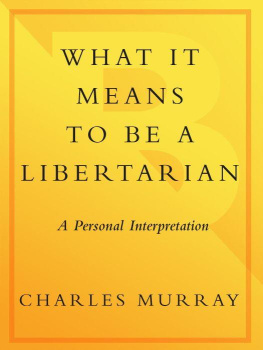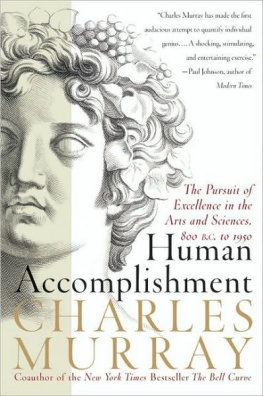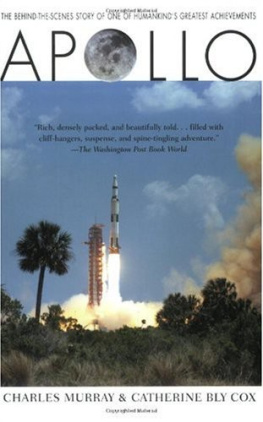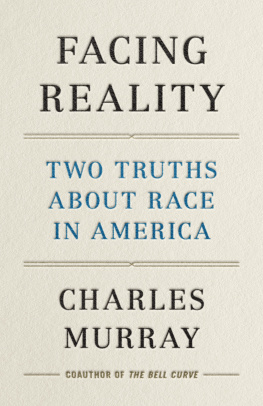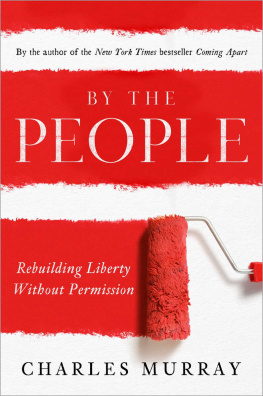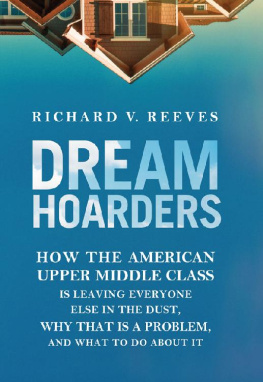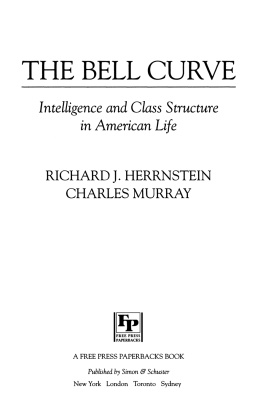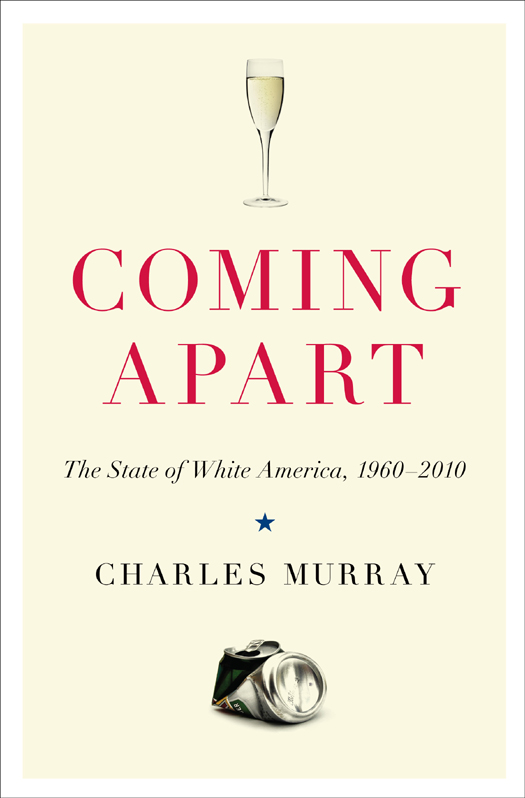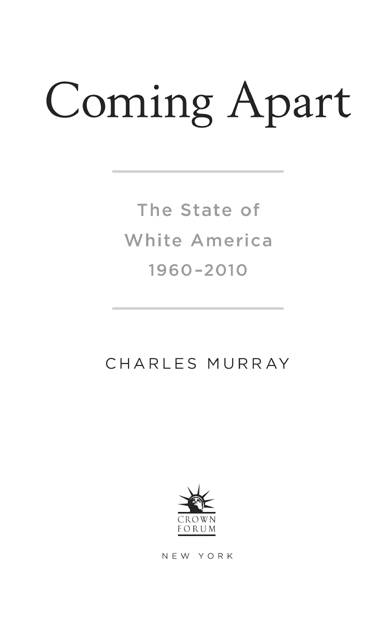ALSO BY CHARLES MURRAY
Human Accomplishment
What It Means to Be a Libertarian
The Bell Curve
Losing Ground
Real Education
Copyright 2012 by Cox and Murray, Inc.
All rights reserved.
Published in the United States by Crown Forum, an imprint of the Crown Publishing Group, a division of Random House, Inc., New York.
www.crownpublishing.com
CROWN FORUM with colophon is a registered trademark of Random House, Inc.
Cataloging-in-Publication Data is on file with the Library of Congress.
eISBN: 978-0-307-45344-0
Jacket design: Base Art Co.
Jacket photographs: (champagne flute) Thomas Northcut/Photodisc/Getty Images; (crushed can) iStockphoto
v3.1
To Catherine,
my touchstone
Contents

Part I
The Formation of a New Upper Class
Part II
The Formation of a New Lower Class
Part III
Why It Matters
Prologue

November 21, 1963
IN RETROSPECT , a single day often comes to demarcate the transition between eras. Never mind that the Continental Congress voted to declare the colonies independence on July second and that the document probably wasnt signed until August. The Fourth of July, the day the text of the Declaration of Independence was adopted, will forever be the symbolic first day of the new nation. In the twentieth century, December 7, 1941, became the symbolic end of an America that held the world at arms length and the beginning of America the superpower. November 22, 1963, became the symbolic first day of what would be known as the Sixties and of the cultural transformation that wound its course through the subsequent decades. The symbolic last day of the culture that preceded it was November 21, 1963.
IT WAS A THURSDAY . New York City saw a trace of rain that day, with a high of fifty-six, ending several days run of late-autumn sunshine. As dusk fell at CBS headquarters at 485 Madison Avenue, Walter Cronkite was in the anchor chair for The CBS Evening News. Just a year and a half into his job, Cronkite was not yet the nations Uncle Walter. He wasnt even the nations leading anchorman. His ratings had lagged behind those of Huntley and Brinkley on NBC from the beginning, and the shift in September from a fifteen-minute program to a half-hour program had done nothing to close the gap.
There wasnt much news to spice up the broadcast this evening. The day had produced one good human-interest story: Robert Stroud, the Birdman of Alcatraz, had died in his sleep at the federal prison in Springfield, Missouri, that morning. But otherwise, the news was humdrum. The Senate Armed Services Committee had approved President Kennedys nomination of Paul Nitze to be secretary of the navy. House minority leader Charles Halleck held a press conference in which he said that he did not see how the presidents civil rights bill could get to the floor of the House before the Christmas recessno surprise, given the many ways in which the all-powerful Rules Committee, dominated by southern Democrats, could delay the process. On Wall Street, the Dow industrials had dropped more than 9 points, more than 1 percent of the Dows opening 742. Nobody was especially worried, however. The October figures for housing starts and durable goods had just come out, providing more evidence that the economy was on the upswing.
CBS might have been number two in evening news, but it was number one in prime-time programming. The Neilsen ratings that week placed eight CBS programs in the top ten, led by The Beverly Hillbillies with a rating of 34.9, meaning that 34.9 percent of all American homes with a television set were watching it. Since 93 percent of American homes had a television set by 1963, the upshot was that the same program was being watched in almost a third of all the homes in the United States. Those same staggering numbers went deep into the lineup. All of the top thirty-one shows had ratings of at least 20. By way of comparison, the number one show in the 200910 season, American Idol, considered to be a gigantic hit, had a rating of 9.1.
The explanation for the ratings of 1963 is simple: There wasnt much choice. Most major cities had only four channels (CBS, NBC, ABC, and a nonprofit station of some sort) at most. People in some markets had access to just one channelthe monopoly in Austin, Texas, where the lone station was owned by Lady Bird Johnson, was the most notorious example.
The limited choices in television viewing were just one example of something that would come as a surprise to a child of the twenty-first century transported back to 1963: the lack of all sorts of variety, and a simplicity that now seems almost quaint.
Popular music consisted of a single Top 40 list, with rock, country, folk, and a fair number of Fifties-style ballads lumped together. No separate stations specializing in different genres, except for country music stations in a few parts of the nation. Except in university towns and the very largest cities, bookstores were small and scarce, usually carrying only a few hundred titles. No Amazon. If you didnt see a movie during the week or two it was showing in your town, you would probably never see it. No DVDs. With television, you either saw a show the night it played or waited until it was repeated once during the summer. No TiVo.
People drove cars made in the United States. Foreign cars from Europe were expensive and rare. Cars from Japan had just been introduced in 1963, but had not been greeted with enthusiasmmade in Japan was synonymous with products that were cheap and shoddy. You might see an occasional sports car on the roadFords Thunderbird or Chevrolets Corvettebut the vast majority of customers chose among sedans, convertibles, and station wagons made by General Motors, Ford, or Chrysler.
The typical American city of 1963 had appallingly little choice in things to eat. In a large city, you would be able to find a few restaurants serving Americanized Chinese food, a few Italian restaurants serving spaghetti and pizza, and a few restaurants with a French name, which probably meant that they had French onion soup on the menu. But if you were looking for a nice little Szechuan dish or linguine with pesto or sauted fois gras, forget it. A Thai curry? The first Thai restaurant in the entire nation wouldnt open for another eight years. Sushi? Raw fish? Are you kidding?

ON THIS THURSDAY , November 21, televisions prime-time lineup included The Flintstones, The Donna Reed Show, My Three Sons, Perry Mason, and The Perry Como Show, but it was the fourteenth-rated show, Dr. Kildare, that made Time magazines recommended viewing. The story that week involved a pregnant unmarried teen who had gotten an abortion. She was so psychologically shattered by the experience that even Dr. Kildare couldnt help. He had to refer her to a psychiatrist in another CBS program,


